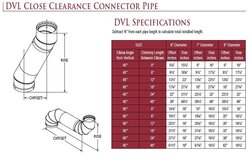So, I'm getting prepared mentally to begin the install of my new Summitt. I'm sure I'll have more questions along the way, but my first is with regard to my chimney set-up. I have a 2 story Victorian that will necessitate a 30' chimney, 6-10' of double wall pipe and 20-25' of Class A stainless. Originally, I had planned to go straight up but my dealer is concerned a 30' chimney would make it difficult to keep from over-firing the stove and could even result in a "runaway" if I were to load it up and leave it. If I were to run the stove pipe at a 22.5 or 45 over to the corner of the room, then run the chimney straight up and out another 25 or so feet, would that help or have the opposite effect? I would actually prefer this so I don't have a chase in the middle of the room above the stove. Thanks.
New Summitt chimney set-up/draft considerations
- Thread starter HotDogMan
- Start date
-
Active since 1995, Hearth.com is THE place on the internet for free information and advice about wood stoves, pellet stoves and other energy saving equipment.
We strive to provide opinions, articles, discussions and history related to Hearth Products and in a more general sense, energy issues.
We promote the EFFICIENT, RESPONSIBLE, CLEAN and SAFE use of all fuels, whether renewable or fossil.


